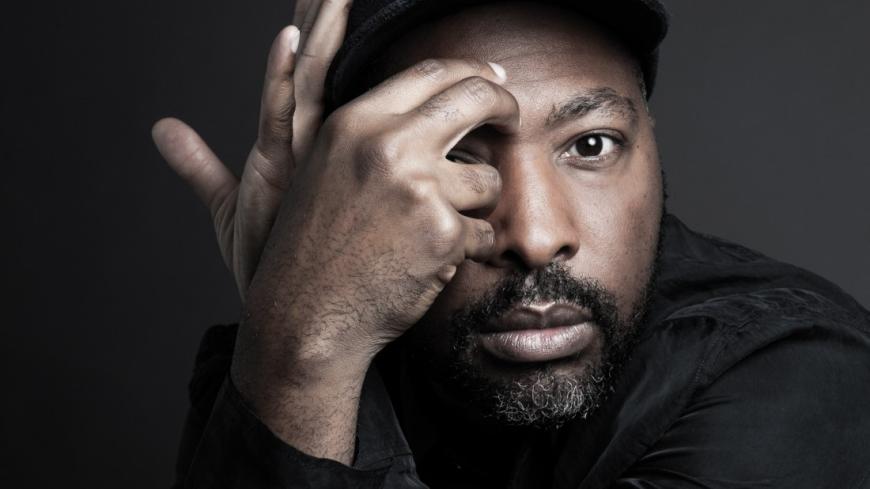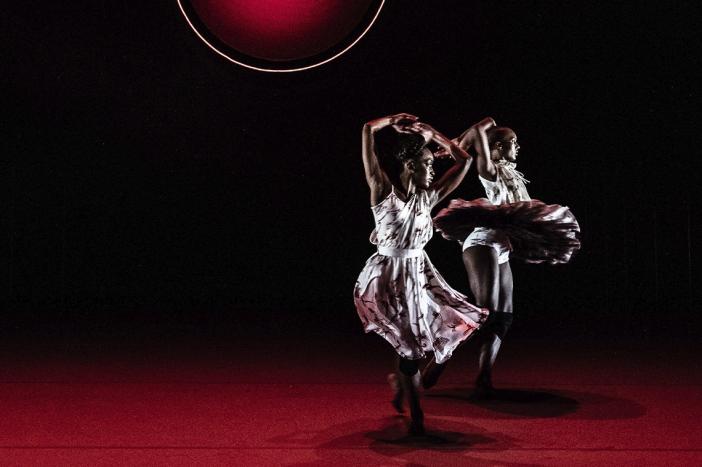
artsmeme founder debra levine recently enjoyed a zoom conversation with the very talented kyle abraham, who has been a choreographer ‘du-moment’ for nearly 15 years. this interview was commissioned, and first published, by the soraya, where a.i.m. by kyle abraham will perform his ‘requiem: fire at the center of the earth’ this saturday night february 18, 2023. it is republished, with permission here.
Kyle Abraham’s name tops any list of most-exciting American choreographers to have emerged in the millennium. But it is his contemporary dance troupe, A.I.M. (Abraham in Motion) by Kyle Abraham, with some of the hottest movers in the field, that will make its exciting Soraya debut on Saturday February 18. The choreographer’s work, Requiem: Fire in the Air of the Earth, is set to Mozart’s Requiem in D minor. Abraham leans into this magisterial music to ruminate on death, reincarnation, and the afterlife, all commensurate themes but seen through the prism of Afro-Futurism, an aesthetic that links African diaspora culture with science and technology.
A throbbing electronic musical score by the pioneering producer, composer, and EDM artist Jlin is spliced into Mozart’s music. Aiding Abraham in staging the mythical world of Requiem are Dan Scully’s lighting and scenic design and innovative costumes by London couturier Giles Deacon.
Abraham, who leads a bicoastal life, chatted recently via Zoom, during down time from his “day job” as a professor of dance at the USC Glorya Kaufman School of Dance.
Kyle, hello. You’ve been in and out of Los Angeles for years. Are you here now?
Hello! Yes, I’m in L.A.
Have you been to The Soraya?
I have been! I came to see a show of Akram Khan’s several years ago. It’s a great venue, I am excited to have my work in that space, the theater still has a newness to it that I find to be really exciting.
Let’s talk about Requiem: Fire in the Air of the Earth. You premiered it in Germany.
It premiered in Hamburg in the summer of 2021, and from Hamburg we performed it in London and Venice at the Biennale, and in Marseilles.
That’s impressive.
I love showing the work in Europe. Audiences there seem to be able to get behind the work. It was interesting to read the initial review of the work in Hamburg, and to see and experience the audiences—that time, first time out of the gate. In the states, it’s been touring for a good while. It has to be seen in a bigger theater where you have more distance, that’s just my personal take…. It’s nice to have some distance and see the floor and the bigger picture.
There are very strong production elements in your Requiem: set/lighting/costume design. You use eerie neon light bars and a big lighting orb at center. Did that aid your creativity, or change your approach?
With all those arenas, the idea about Black Futurism was at the forefront, allowing the collaborators to think about what that meant in dialogue with folklore and mythology and regality. I was thinking about different folklores, like, if there is a duet, I wondered, what would happen if Minerva (Roman goddess of wisdom, justice, law) were to have a conversation with Ohsun (Yoruba deity of love, beauty, fertility). Two different religions, or mythologies, if they were to be in conversation. Making a space for that. All my collaborators had those things in mind during the process. Dan Scully is a longtime collaborator of mind. He was very instrumental in creating the world [of Requiem].
And the soundscape? The mixing-in to Mozart of sound by JLIN?
I had a conversation with Jon Nakagawa from Lincoln Center [since 1999, Director of Contemporary Programming] about his interest in commissioning a Mozart work from me. From the very beginning I was working with the Mozart Requiem. I had studied it a good while—nearly two years just listening, to wrap my head around it. That was pretty early on. But it was also relatively early on that he told me there wouldn’t be live music. Once he said that, I thought to myself [laughs] “So … why are we doing this?” Then I thought, this is an opportunity to focus on ideas of reincarnation and after birth and a reimagining. Coming to mind was the [C.D.] cover art for JLIN. “Black Origami,” a metallic elephant, that had me thinking and that led me to conversations around Black Futurism and a deeper delve into a conversation of reincarnation and after life. I started making material and I would send JLIN videos. During the Pandemic she sent me demos of different songs she had been working on. I was blown away. From there, I knew, okay, I’m going to do this.

The costumes, the dresses on the men, look like medieval warriors—or ragamuffins.
I would send [designer] Giles Deacon photos of the dancers in their own clothes, so he would get a bit of their personality. And that was how he designated, or designed, individual looks. He designed and constructed the costumes in London. Not only was it during the Pandemic, but we were at a residency at the Lumberyard and at Kaatsbaan both in the Hudson Valley area of New York. With everything going on in the world, it made shipping more tricky and complicated. We needed the costumes—to film, photograph, and light the work, create the environment. Well, nobody knew where those costumes were! Everyone operates differently. Some people get on a call and wait for someone to call you back, I’m not one of those people. The drive was an hour and a half in each direction to get those costumes. And I got them.
Is that a red mask over the eyes of the dancers?
It’s a red face paint. They paint that on every show. That was part of Giles’s design, he thought it would create an interesting ‘pop.’
What is next for you, Kyle?
We have a program at The Joyce Theater, April 4 – 9, 2023, that has several New York premieres or world premieres. A work by Maleek Washington, a former company member; a solo work by Bebe Miller; a new work of mine called “MotorRover,” created in response to Merce Cunningham’s “LandRover”; and a suite I made to Nina Simone songs, Our Indigo: If We Were A Love Song . It’s exciting to bring that work to the New York audience.
It sounds like a relief to have shorter works on a program after lengthy ones like Requiem.
[Laughing] Uh, yes, it is!
What’s your take on L.A. versus New York?
I have a living space in New York [and L.A.]. I love the notion of bicoastal living. Each city, between N.Y. and L.A., has a lot to offer, stuff that is not necessarily available in the other space. The challenge for me, for sure, is building solid foundation and support system in either place….going back and forth … and that’s really challenging.
Is the relatively more relaxed lifestyle of Los Angeles beneficial to your creative output?
It can be, depending on the work. It plays a factor where I am starting creation, or where I’m doing the research. In most cases, I am able to have that element of recharge and research when I’m here in L.A.
How do you recharge?
It’s a cliché in that L.A. way, but it’s getting back into my yoga practice. There’s something about studying with my yoga teacher (Chris Reed) that is centering for me. It creates a balance for me to question certain things, while being at peace with certain [other] things. Which all serves the greater good in or out of the [dance] studio.
When you say “research,” what do you mean?
Research to me is in all things. It’s going to museums. Here in L.A., there are wonderful museum and gallery spaces that are not crowded. That’s really lovely. That’s a huge resource for me.
You’re a university professor now. Do you like teaching?
I love teaching. Teaching is definitely one of the elements of recharge that I experience when I have the opportunity to be invested in an educational program. This semester is my first on-campus semester. I was hired during the pandemic—and was on leave my first year in the position. So this is my first legitimate face time with the students.
Teaching recharges you, really?
My favorite thing is teaching composition. The big thing for me about teaching is a genuine reciprocity exists, because the students know I am 100% there to see them succeed. They can see their peers shifting and changing and seeing the “un-huh” moments, based on the collaborative nature and exchange between a student and a teacher. Their seeing that makes some of the magic happen in real time. When [my company is] making dances, which is great to do, it’s not the same kind of process at all.
Requiem: Fire in the Air of the Earth | A.I.M. by Kyle Abraham | The Soraya | Saturday Feb 18
Dance critic Debra Levine who previously wrote feature articles about “Existencia” on behalf of The Soraya, is pleased to share her reaction to the unique showcase here.
